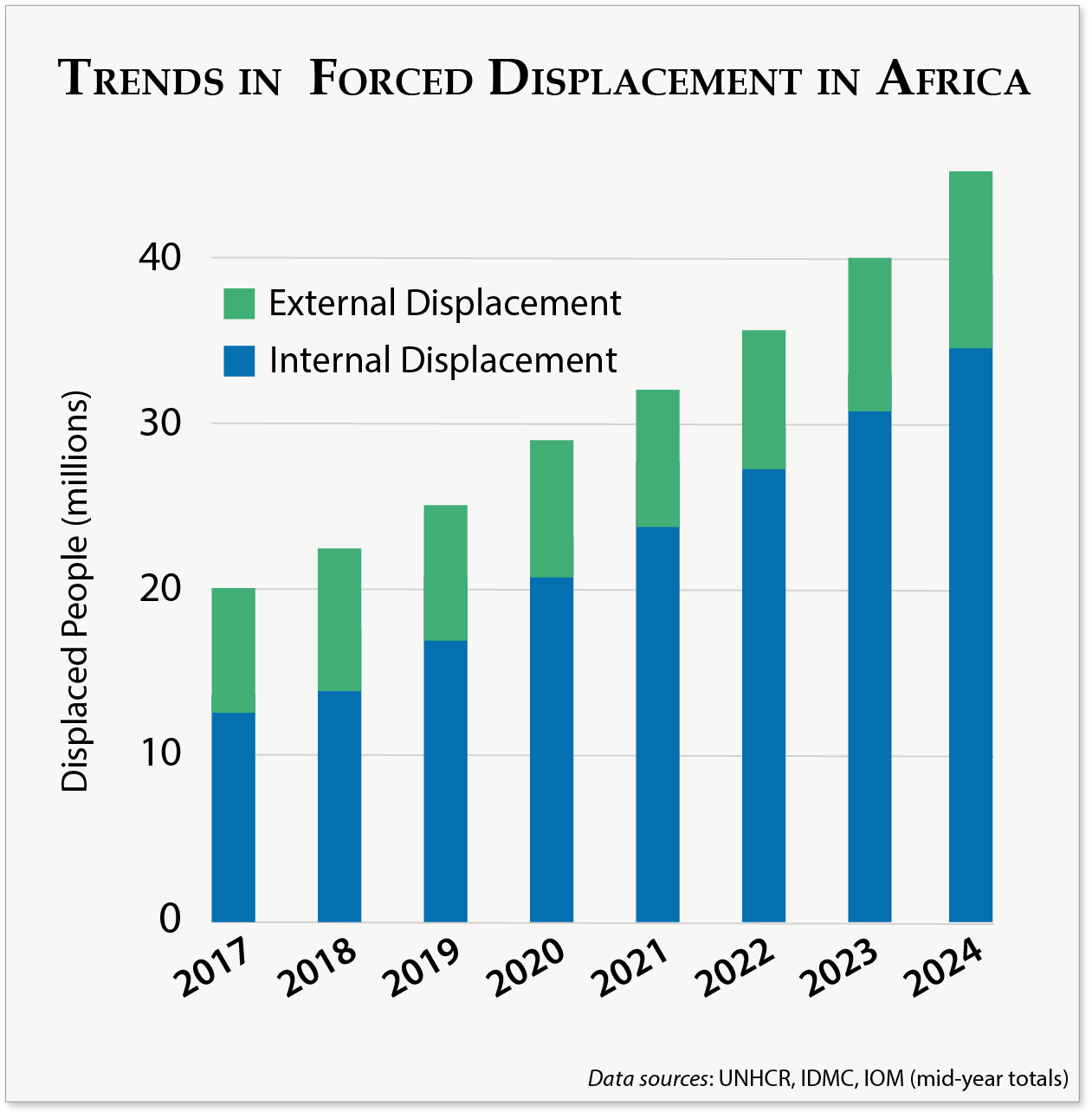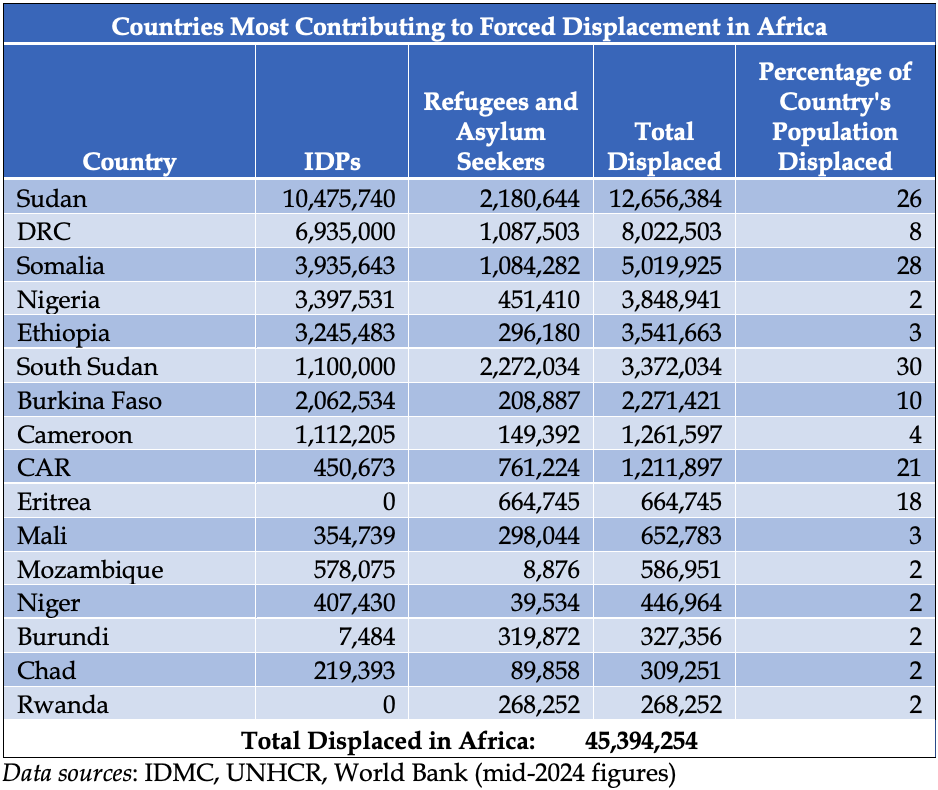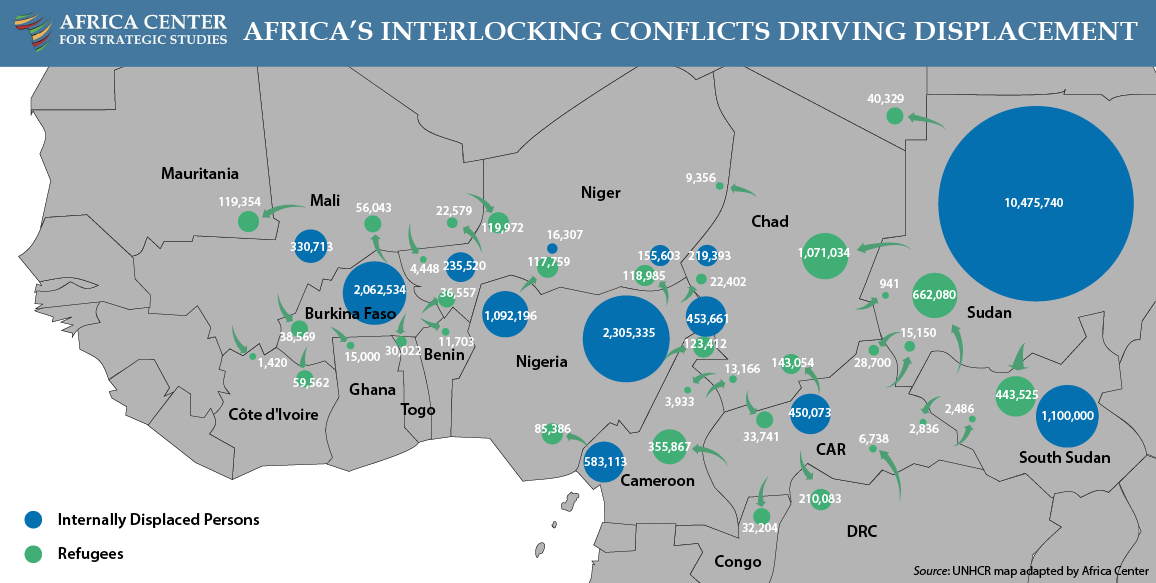 The number of Africans forcibly displaced by conflict and repressive regimes has risen for the 13th year in a row—to over 45 million people. Comprising internally displaced persons (IDPs), refugees, and asylum seekers, this figure represents a 14-percent increase from the previous year. With 3 percent of its total population forcibly displaced, Africa has both a larger share and absolute number of forcibly displaced people than any other major region in the world.
The number of Africans forcibly displaced by conflict and repressive regimes has risen for the 13th year in a row—to over 45 million people. Comprising internally displaced persons (IDPs), refugees, and asylum seekers, this figure represents a 14-percent increase from the previous year. With 3 percent of its total population forcibly displaced, Africa has both a larger share and absolute number of forcibly displaced people than any other major region in the world.
Given the persistent growth in displacement, there has been a doubling in the forcibly displaced population in Africa since 2018. Three-quarters of these people—34.5 million—are internally displaced. This represents a near tripling in the number of internally displaced people in Africa since 2017. With 1.9 million newly reported internally displaced since the start of 2024, Africa now hosts more than 48 percent of the world’s IDPs.
There has been a doubling in the forcibly displaced population in Africa since 2018
Conflict has consistently been the leading driver of displacement on the continent. Only two of the African countries with more than 250,000 people displaced were not experiencing conflict. Citizens of these two—Eritrea and Rwanda—face some of the highest levels of domestic repression on the continent. Notably, nearly all of the displacement in these two countries is external.
 The spike in displacement over the past year is mostly attributed to the conflict in Sudan, which recorded a 5.35-million-person increase in internally displaced over the past year. Sudan, though, is just one of 9 African countries with forcibly displaced populations of more than 250,000 that had increased displacement during this period. In 6 African countries, more than 10 percent of the population is forcibly displaced, underscoring both the breadth and depth of this instability.
The spike in displacement over the past year is mostly attributed to the conflict in Sudan, which recorded a 5.35-million-person increase in internally displaced over the past year. Sudan, though, is just one of 9 African countries with forcibly displaced populations of more than 250,000 that had increased displacement during this period. In 6 African countries, more than 10 percent of the population is forcibly displaced, underscoring both the breadth and depth of this instability.
The 9 African countries with more than 1 million displaced account for more than 90 percent of the total forcibly displaced population in Africa: Sudan, the Democratic Republic of the Congo (DRC), Somalia, Nigeria, Ethiopia, South Sudan, Burkina Faso, Cameroon, and the Central African Republic (CAR). Four of the top six sources of forced displacement are in East Africa, underscoring the compounding regional implications of ongoing conflicts.
This compounding fragility caused by Africa’s unresolved conflicts is a vital feature of the African security environment. African countries host over 98 percent of African refugees and asylum seekers. This is particularly notable considering the enormous strains many of these countries face, including almost half experiencing conflict themselves.
Following is an assessment of the countries experiencing the greatest dynamism in their levels of forced displacement.
Sudan
12,656,000 Sudanese forcibly displaced
5.35 million increase (73% change)
- Sudan has the highest number of IDPs in the world and has generated the second highest number of total displacement globally (currently more than 12.6 million) compared to Syria’s almost 13.8 million.
- The power struggle between the Sudanese Armed Forces (SAF) and paramilitary Rapid Support Forces (RSF) exploded into conflict in April 2023—and the impacts on Sudanese civilians have been worsening ever since. Roughly 1.4 million Sudanese citizens have fled the country and almost 10.5 million (including 2.8 million previously displaced) are IDPs (1 out of every 5 people in the country).
- The 5.35 million Sudanese who were displaced over the past year has made Sudan far and away the largest source of forcibly displaced people in Africa, with nearly 12.7 million. A year earlier, Sudan and the DRC were at comparable levels (just over 7 million).
The spike in African displacement over the past year is mostly attributed to the conflict in Sudan
- An additional 909,000 non-Sudanese living in Sudan (mostly refugees from neighboring countries) have also been displaced. Most of these people have had to return to their countries of origin, which are still experiencing conflict, straining the fragility of the region.
- Ethnic cleansing at the hands of the RSF is happening again in Darfur, which is experiencing its worst violence since 2005. Experts say this violence—largely targeting the Masalit community—may amount to war crimes and crimes against humanity.
- An estimated 25.6 million people in Sudan (more than half the country’s population of 47.2 million) face acute food insecurity (IPC Phase 3 (Crisis) or above), including 755,000 facing famine. The UN has accused the warring parties of weaponizing access to food. Estimates are that 2.5 million people could die from famine if humanitarian access is not secured.
Democratic Republic of the Congo
8,023,000 Congolese forcibly displaced
881,000 increase (12% change)
- Deteriorating stability—primarily in the eastern provinces of North Kivu, South Kivu, and Ituri—has resulted in the displacement of an additional 752,000 people in the DRC since the beginning of 2024. The number of Congolese IDPs stands at 6.9 million, the highest ever reported for the country.
- The instability in the DRC is multifaceted. A key driver of the recent displacement has been the seizing of more territory and attacks on civilian settlements in the east by the Rwandan-backed M23 militia. The undisciplined response by the armed forces of the DRC and their Wazalendo militia allies—who have engaged in looting, extorting, kidnapping, and murdering civilians—has triggered additional displacements. Regional rivalries between Rwanda, Burundi, and Uganda further fuel support for proxy forces and risk escalating into a full-blown regional conflict.
- Violent criminal groups like the Allied Democratic Forces (ADF) and the Cooperative for Development of the Congo (CODECO) have been responsible for indiscriminate violence against civilians resulting in hundreds of civilian deaths, primarily in North Kivu and Ituri, respectively.
- Competition by the rival armed groups for critical minerals (including gold, cobalt, and coltan) and precious timber, driven by global demand, have further added to the instability.
- The UN peacekeeping mission, MONUSCO, continues to play a critical stabilizing role, protecting an estimated 6.5 million IDPs in the northeastern DRC. This includes demining, community-based early warning systems, judicial capacity building, community conflict resolution, and collaborative mechanisms for civilian protection.
Ethiopia
3,542,000 forcibly displaced
119,000 increase (3% change)
- Ethiopia saw an increase of 119,000 in its forcibly displaced population over the last 12 months due to continued clashes between federal forces and ethnic militias in Amhara and Oromia regions.
The conflict in Sudan has caused more than 69,000 Ethiopians and an almost equal number of Sudanese to flee across the border into the Amhara region.
- This increase follows the dramatic 1.2 million person decline in Ethiopia’s forcibly displaced population subsequent to the signing of the cessation of hostilities agreement in Tigray in 2022.
- The conflict in Sudan has caused more than 69,000 Ethiopians and an almost equal number of Sudanese to flee across the border into the Amhara region.
- The World Food Program estimates approximately 4 million IDPs face acute food insecurity. Those in Tigray and northeastern Amhara face IPC Phase 4 (Emergency) levels of hunger. Sudanese refugees in Amhara are also among those experiencing Emergency level hunger.
Burkina Faso
Roughly 3 million Burkinabe forcibly displaced
135,000 reported increase (5% change)
- With the deteriorating security in Burkina Faso, estimates are that the number of forcibly displaced is roughly 3 million—more than 10 percent of the population. This displacement has been caused by militant Islamist groups that now control roughly 60 percent of Burkina Faso territory and have besieged 75 towns and cities.
Burkina Faso’s military junta discontinued reporting IDP numbers in March 2023, when the number of reported displacements were estimated at 2.27 million.
- Burkina Faso’s military junta discontinued reporting IDP numbers in March 2023, when the number of reported displacements were estimated at 2.27 million.
- Suspensions of media outlets and intimidation of journalists who report on the deteriorating security, severely limit access to reliable displacement figures.
- Displacement is further driven by violence against civilians by Burkinabe security forces. Over the last 12 months, these forces are reported to have killed more than 1,160 civilians in the name of combatting violent extremist groups.
Cameroon
1,262,000 forcibly displaced
54,000 increase (4% change)
- Forced displacement in Cameroon has been driven by two conflicts in its border regions, resulting in almost 1.3 million displaced people.
- In the north, threats from Boko Haram and the Islamic State in West Africa have spilled over Nigeria’s border for the past decade. The number of violent events and fatalities linked to these militant Islamist groups have more than doubled over the last 12 months. For the first time, there were more violent events in Cameroon than in Nigeria.
- In the west, persistent violence has been linked to the government’s response to the country’s two Anglophone regions seeking greater rights and decentralization of government. Over 5,500 people have been killed in this conflict since 2016.
Mali
653,000 forcibly displaced
57,000 increase (9% change)
- Levels of forced displacement in Mali continue to expand as the security situation deteriorates. Violence linked to militant Islamist groups has grown and these militant actors now control an estimated 50 percent of the country.
- Forced displacement has been exacerbated due to a spike in the number of attacks on civilians by the Malian military and Russian paramilitary forces. The 1,250 fatalities inflicted on civilians at the hands of security forces over the past 12 months is almost 3 times more than the 430 linked to militant Islamist groups over the same period.
Forced displacement has been exacerbated due to a spike in the number of attacks on civilians by the Malian military and Russian paramilitary forces.
- The Malian junta has actively suppressed reporting in the country. Independent assessments have been further limited by the junta’s demand that the UN peacekeeping force, MINUSMA, depart. The resulting information vacuum suggests figures on violent events, forced displacement, and food insecurity are all significantly undercounted.
- Best estimates indicate that in addition to the 354,000 internally displaced, there are almost 4 million facing acute food insecurity (above ICP Level 3) in Mali.
Niger
447,000 forcibly displaced
65,000 increase (17% change)
- Reported forced displacements in Niger have increased by 17 percent over the past year following the military coup in July 2023.
- The number of fatalities linked to the militant Islamist insurgency has spiked by over 200 percent from 404 to 1,265 in the past year. The militant groups have spilled across both the Burkina Faso and Mali borders, uprooting communities in the north and west of the country.
- An escalation in militant Islamist group violence along the border with Mali is expected to provoke further population movements in Niger.
- The precipitous decline in security in Niger has been accompanied by a deterioration in a host of economic and other measures of citizen well-being.
Notable Non-Conflict-Related Displacement
Eritrea
665,000 forcibly displaced
36,000 increase (6% change)
- The reported 36,000 Eritreans that sought refuge or asylum over the past 12 months represents a 6-percent increase from an already substantial baseline displacement figure. The 655,000 forcibly displaced Eritreans means that at least 18 percent of the population has fled from the government’s repression.
- Eritrea has experienced a steady rate of forced displacement since its independence in 1993 given the government’s widespread use of indefinite national service, arbitrary detentions, and enforced disappearances. The latest increase represents a continuation of that trend as well as instability in Ethiopia and Sudan.
- Ethiopia suspended the registration and processing of Eritrean asylum claims in 2021, leaving many Eritreans with no status. Following the conflict in Tigray, Eritrean refugees (registered and unregistered) in Ethiopia experienced roundups, leading to deportations to Eritrea. As a result, many Eritreans have sought refuge in countries further afield, where they likely received official refugee status.
- The conflict in Sudan has also displaced many Eritrean refugees. Fear of the violence and abuses committed against Eritreans by the RSF as well as stories of the Eritrean government forcibly repatriating displaced Eritrean refugees have incentivized those who can to seek refuge in other countries.
Notable Declines in Forced Displacement
Mozambique
578,000 forcibly displaced
256,000 decrease (-30% change)
- Mozambique saw roughly 256,000 IDPs return to their homes over the last 12 months in large part due to improved security following deployments by Southern African Development Community (SADC) and Rwandan forces against the militant Islamist insurgency in the northeastern part of the country that has claimed more than 6,500 lives since 2018.
South Sudan, Nigeria, Somalia, and Chad have also recorded declines in levels of forced displacement, though these decreases may be transitory, due to changes in reporting methodology, or attributable to factors other than improved prospects for those who are displaced.




